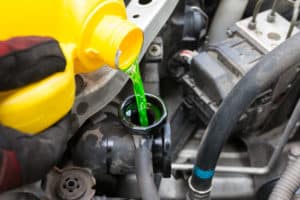How to tell if your coolant needs replacing?

One of the leading causes of car breakdowns are problems with its cooling system. Neglecting regular maintenance can cause serious damage and complete engine failure. However, we can help you figure out how to tell if your coolant needs replacing. Here are some common tell tale signs that you may be in need of a coolant change.
#1 Low Coolant Level
One common maintenance issue vehicle owners should consider is making sure they remember to check the coolant level periodically. If your coolant level is low, your car’s coolant light should turn on, meaning that there’s not enough coolant for the engine to function properly. In this case, a 50/50 mix of coolant (antifreeze) and distilled water should be added to the radiator or the cooling system reservoir, as well as a visual inspection of hoses, belts and the radiator in order to find if there are any leaks that can be causing the low coolant level.
#2 Changes In Coolant Colors
The most common coolant colors are light green, yellow and orange. Knowing the color of your vehicle’s coolant when it’s new can help you identify any changes or signs that your coolant needs to be replaced.
When rust appears in your coolant, for instance, it shows up as a red tone. Rust can clog the cooling system and eventually cause your engine to overheat, so it’s important to check it periodically to make sure everything’s working as it should be.
If you notice a black color inside the radiator or coolant reservoir container jug, it may be engine oil from a head gasket leaking internally causing the coolant to turn a blackish color.
#3 A Sweet Smell Is Coming From Your Engine
It’s not a normal sign that your car’s engine is sending out a sweet smell; instead it could be a clue your coolant needs replacing.
Many coolants contain a chemical called “ethylene glycol” which can produce a sweet smelling scent once it starts burning off, though it could also be a sign that a radiator hose is leaking or that the heater core is causing the smell. If when doing a check-up you hear a hissing noise coming from the engine, the best thing to do would be to turn off the engine and contact a technician right away. If ignored, these sort of issues could cause your engine to be severely damaged, meaning higher repair costs in the end.
#4 The Heating System Isn’t Working
Similar to a cooling system is the heating system. In the heating system, the hot coolant is pumped throughout the engine, passing on to the heater core which is a smaller radiator that pushes the air through the air vents and into the car. If your heater has suddenly stopped working, this could be a tell tale sign your coolant needs replacing.
#5 Your Car Is Overheating
Once your engine has started overheating that means the problem has gotten more serious and you should call a specialist as soon as possible.
Signs that your vehicle is overheating would be its temperature gauge coming closer to the danger zone (the gauge needle is more toward the right side of the gauge, red or HOT), steam or hissing sounds coming from under the hood or the smell of your engine running hot.
Although all of these signs are obvious clues that show you your coolant needs to be replaced, it’s important to do a check up on vehicles with more than 50,000 miles. Do not wait until these sort of issues start coming up since it may be too late by them.
Coolant can deteriorate over time, which is why it should be tested frequently to see if it’s still any good. it becomes more acidic overtime and can lose its rust-inhibiting properties and start causing corrosion, which in turn damages the radiator, water pump, thermostat and other parts of the cooling and heater system.
At USA Automotive, our expert technicians can inspect your vehicle’s cooling system to help prevent premature failure, or we can handle it once something has started to fail. Call to arrange a visit today at 919-231-8777 or visit us on-line to set up an appointment.

Leave a Reply
You must be logged in to post a comment.